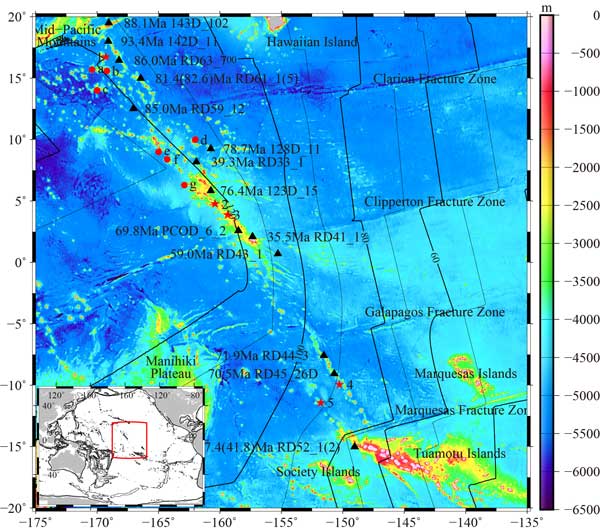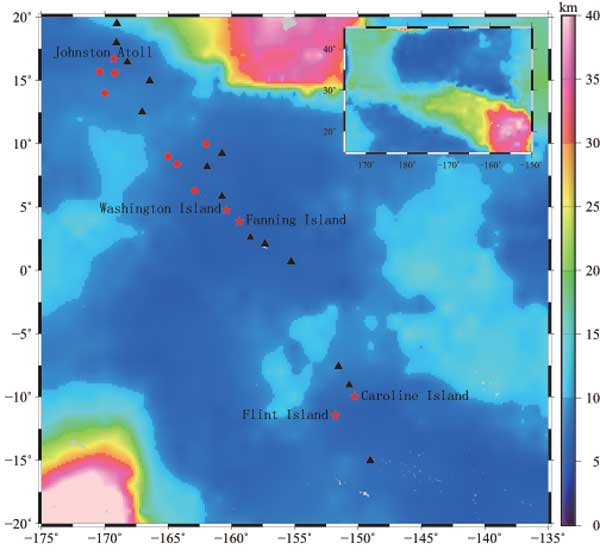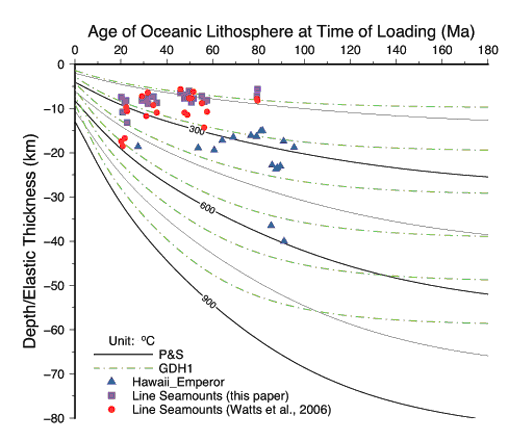 |
Three-dimensional lithospheric effective elastic thickness of the Line ridge |
Minzhang Hu1,2, Jiancheng Li2, Taoyong Jin2, Xinyu Xu2, Lelin Xing1, Chongyang Shen1 & Hui Li1
1Key Laboratory of Earthquake Geodesy, Institute of Seismology, China Earthquake Administration, 40 Hongshan Celu, Wuhan, China; mzhhu@whu.edu.cn ; xinglelin@163.com ; scy907@163.com ; lihuieq@163.com
2Institute of Geodesy and Geophysics, School of Geodesy and Geomatics,Wuhan University, 129, Luoyu Road, Wuhan, China; jchli@whu.edu.cn ; tyjin@whu.edu.cn ; xyxu@whu.edu.cn
This webpage is a summary of: Hu, M., Li, J., Jin,T., Xu, X., Xing, L., Shen, C. and Li, H. (2015) Three-dimensional estimate of the lithosphere effective elastic thickness of the Line ridge. Tectonophysics, 658, 61-73, DOI: 10.1016/j.tecto.2015.07.008.
Introduction
The Line ridge is a seamount chain located in the center of the Pacific Ocean (Figure 1). Some scientists argue that the Line ridge was generated by “hot spots” (Morgan, 1972; Schlanger et al., 1984) while others suggest that it is the product of a mid-ocean ridge (Winterer, 1976; Nakanishi, 1993). Natland (1976) linked certain branches of the ridge to rifting of the seafloor. Volcanism along the ridge does not display linear age progressions, and cannot be attributed to hot spots sustained by deep mantle plumes. The long duration of volcanism and quasi-synchronous activity over great distance call for a different explanation.

Figure 1: A 1 × 1 minute bathymetry model created using ship soundings and vertical gravity gradient anomaly data (BAT_VGG) (Hu et al., 2014). Seafloor age data from Müller et al. (2008) are shown as contours (unit: Ma). Red stars: islands of the Line Seamounts: 1 Johnston Atoll, 2 Washington Island, 3 Fanning Island, 4 Caroline Island, and 5 Flint Island. Red circles: seamounts whose ages have been determined by Davis et al. (2002): a Keli Ridge West, b Keli Ridge East, c Smt.14N 170W, d Smt.10N 162W, e Smt.9N 165W, f S.P. Lee Guyot, and g Kingman Reef. Black triangles: samples from Schlanger et al. (1984). Click here or on Figure for enlargement.
New work
We re-calculated the lithospheric effective elastic thickness (Te) of the Line ridge using the moving window admittance technique introduced by Kalnins & Watts (2009). The results show that the Te of the Line ridge is in the range 5.5-13 km, with an average of 8 km and a standard deviation of 1.3 km. Te along the ridge does not change progressively, but instead is segmented (Figure 2). The strength of the lithosphere beneath both the north and south parts the Line Islands (8-12 km) is slightly higher than beneath the other areas (4-8 km). The Te of the Hawaiian-Emperor chain is shown in the upper-right corner of Figure 2 for comparison. This chain, thought to be constructed by a “hot spot”, exhibits Te that decreases gradually from the southeast to the northwest. This comparison suggests that the Line ridge has been modified by tectonic activity other than those associated with a “hot spot”.

Figure 2: Te of the lithosphere beneath the Line ridge and adjacent areas. Te of the Hawaiian-Emperor chain is shown in the inset in the upper-right corner for comparison.
Discussion
Many studies suggest that the oceanic Te can be determined to a first order by the age of the lithosphere at the time of loading and is approximately represented by the depth of the 300-600°C isotherms (Calmant et al., 1990; Watts, 2001). Both the Te of the Line ridge and the Hawaiian-Emperor seamounts are shown in Figure 3. As can be seen in this Figure, the Te along most of the Hawaiian-Emperor seamounts corresponds to the 300-450°C isotherm, while for the Line ridge most of the Te values correspond to the 150-300°C isotherm depth. This is significantly shallower than the depth given by Watts (2001).
The ages of the lithosphere at the time of seamount loading appear to be concentrated in two periods: 20-35 Ma and 40-60 Ma. Despite the age differences, this study found similar Te for the lithosphere of these age groups. Thus, the strength of the lithosphere under the Line ridge is not solely controlled by the age of the lithosphere at the time of loading, but the thermal activity and fracture activation must have played an important role in the origin and evolution of the ridge. The wide distribution of seamounts and the volcano ages along the Line Islands suggest that small-scale sublithospheric convection (SSC) may be responsible (Ballmer et al., 2009).
Volcanism continued for about 60 Ma on seafloor older than 100 Ma. This can be explained by the SSC model [Ed: see also Small-scale convection webpage] with high reference mantle temperature. It is reasonable to suppose that mantle temperature under the Line ridge is higher than normal because it lies near the south Pacific “superswell” [Ed: see also Superswell webpage].

Figure 3: Relationship between effective elastic thickness and age of the oceanic lithosphere at the time of loading. (P&S: model of Parsons and Sclater (1977); GDH1: model of Stein and Stein (1992). Purple squares: results described in this webpage, red circles: results from Watts et al. (2006), blue triangles: results for the Hawaiian-Emperor seamounts.
References
-
Ballmer, M.D., Hunen, J., Ito, G., Bianco, T.A., Tackley, P.J., 2009. Intraplate volcanism with complex age-distance patterns: A case for small-scale sublithospheric convection. Geochem. Geophys. Geosyst., 10, Q06015, DOI: 10.1029/2009GC002386.
-
Calmant, S., Francheteau, J., Cazenave, A., 1990. Elastic layer thickening with age of the oceanic lithosphere: a tool for prediction of the age of volcanoes or oceanic crust. Geophys. J., 100, 59-67. DOI: 10.1111/j.1365-246X.1990.tb04567.x
-
Davis, A.S., Gray, L.B., Clague, D.A., Hein, J.R., 2002. The Line Islands revisited: New 40Ar/39Ar geochronologic evidence for episodes of volcanism due to lithospheric extension. Geochem. Geophys. Geosyst., 3, DOI: 10.1029/2001GC000190.
-
Hu, M., Li, J., Li, H., Shen, C., Jin, T., Xing, L., 2014. Predicting global seafloor topography using multi-source data, Marine Geodesy, DOI: 10.1080/01490419.2014.934415.
-
Hu, M., Li, J., Jin,T., Xu, X., Xing, L., Shen, C. and Li, H. (2015) Three-dimensional estimate of the lithosphere effective elastic thickness of the Line ridge. Tectonophysics, 658, 61-73, DOI: 10.1016/j.tecto.2015.07.008.
-
Kalnins, L.M., Watts, A.B., 2009. Spatial variations in effective elastic thickness in the western Pacific ocean and their implications for Mesozoic volcanism. Earth Planet. Sci. Lett., 286, 89-100. DOI:10.1016/j.epsl.2009.06.018.
-
Morgan, W.J., 1972. Deep mantle convection plumes and plate motions. Amer. Assoc. Petrol. Geol. Bull., 56, 203-213.
-
Müller, R.D., Sdrolias M., Gaina, C., Roest, W.R., 2008. Age, spreading rates, and spreading asymmetry of the World’s ocean crust. Geochem. Geophys. Geosyst., 9, 1-19. DOI:10.1029 /2007GC001743.
-
Nakanishi, M., 1993. Topographic expression of five fracture zones in the northwestern Pacific ocean, in the Mesozoic Pacific: geology, tectonics and volcanism, Geophys. Monograph Ser., 77, edited by M.S. Pringle, W.W. Sager, W.V. Sliter, and S. Stein, pp. 121-136, AGU, Washington, D.C. DOI: 10.1029/GM077p0121.
-
Natland, J.H., 1976. Petrology of volcanic rocks dredged from seamounts in the Line Islands. Initial Rep. Deep Sea Drill. Proj. 33, 26, 749-777.
-
Parsons, B., Sclater, J.G., 1977. An analysis of the variation of ocean floor bathymetry and heat flow with age. J. Geophys. Res., 82, 803-827. DOI: 10.1029/JB082i005p00803.
-
Schlanger, S.O., Garcia, M.O., Keating, B.H., Naughton, J.J., Sager, W.W., Haggerty, J.A., Philpotts, J.A., Duncan, R.A., 1984. Geology and geochronology of the Line Islands. J. Geophys. Res., 89, 11261-11272. doi: 10.1029/JB089iB13p11261.
-
Stein, C.A., Stein, S., 1992. A model for the global variation in oceanic depth and heat flow with lithospheric age. Nature, 359, 123-129. DOI:10.1038/359123a0.
-
Watts, A.B., 2001. Isostasy and flexure of the lithosphere. Cambridge University Press, London.
-
Winterer, E.L., 1976. Bathymetry and regional tectonic settings of the Line Islands chain. Initial Rep. Deep Sea Drill. Proj., 33, 25, 731-748.
last updated 17th
October, 2015 |
